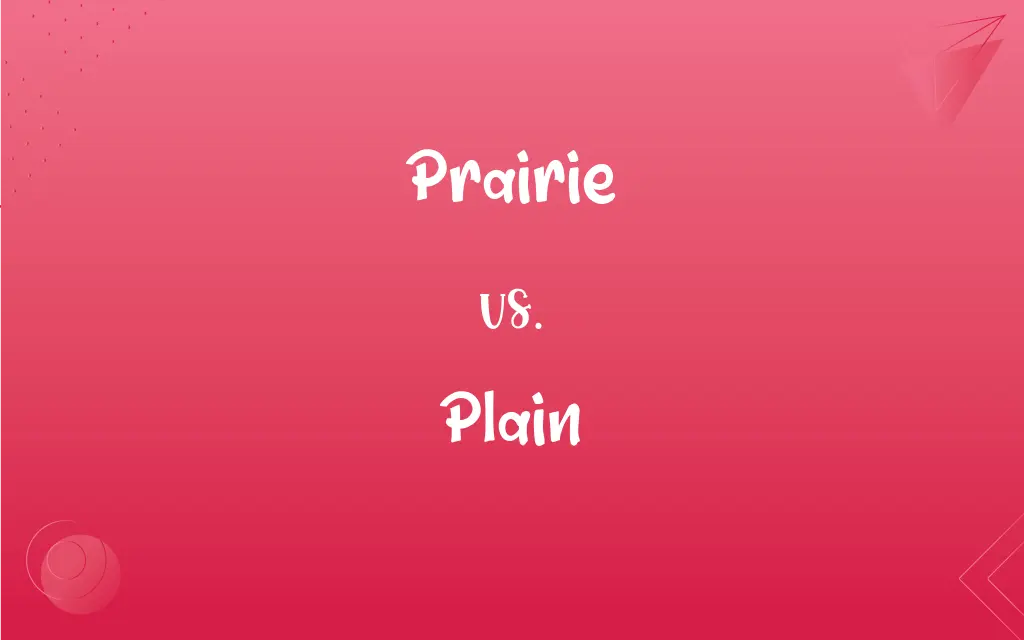Prairie vs. Plain: What's the Difference?
Edited by Aimie Carlson || By Harlon Moss || Published on February 9, 2024
Prairie is a grassland ecosystem, typically in North America, characterized by tall grasses. Plain is a broad, flat area of land with sparse vegetation.

Key Differences
Prairies are ecosystems primarily found in North America, known for their tall, dense grasses and often hosting a rich diversity of flora and fauna. Plains, on the other hand, are large, flat expanses of land that can be found worldwide, characterized by their sparse vegetation, which may include grass but often is more varied or even barren.
Prairies are a distinctive feature of the North American landscape, especially in the United States and Canada, while plains are a more globally widespread geographical feature, found on every continent and encompassing various types of landscapes, from savannas in Africa to steppes in Asia.
Prairies hold significant cultural importance in North American history, often associated with the era of westward expansion and the image of the American frontier. Plains, in contrast, have been crucial throughout human history, serving as sites for early human settlements, agriculture, and cross-continental travel routes.
Prairies typically exist in regions with a specific climate that supports grassland ecosystems, often with distinct seasonal variations. Plains can exist in a variety of climatic conditions, from the cold tundras to the hot and dry deserts, depending on their geographical location.
Prairies have often been converted into agricultural land due to their fertile soil, and they play a vital role in supporting wildlife and biodiversity. Plains have been used for a range of human activities, from agriculture to urban development, depending on their soil fertility, climate, and location.
ADVERTISEMENT
Comparison Chart
Location
Primarily North America
Worldwide
Vegetation
Dominated by tall grasses
Varied, often sparse or specific to the region
Ecosystem
Rich in biodiversity, specific to grasslands
Can vary from deserts to forests
Cultural Significance
Associated with American frontier and expansion
Historical significance in human settlement
Climate
Specific to grasslands, with seasonal variations
Varies widely, from arctic to tropical climates
ADVERTISEMENT
Prairie and Plain Definitions
Prairie
An ecosystem with diverse plant and animal life.
The prairie ecosystem supports numerous bird species.
Plain
Characterized by sparse or specific regional vegetation.
The plain was covered in a blanket of wildflowers.
Prairie
A natural habitat for wildlife like bison and prairie dogs.
Bison roamed freely across the prairie.
Plain
A broad, flat area of land with few trees.
The plain extended to the horizon, a vast open land.
Prairie
Often used for agriculture due to fertile soil.
They farmed wheat and corn on the rich prairie soil.
Plain
A common geographical feature found globally.
The Serengeti Plain is known for its wildlife.
Prairie
Symbolic of American heritage and folklore.
The prairie is often depicted in stories of early settlers.
Plain
Can include various ecosystems like tundras or deserts.
The Arctic plain was starkly beautiful.
Prairie
A vast area of grassland, particularly in North America.
The prairie stretched endlessly, covered in tall grass.
Plain
Used for human settlement and agriculture.
Ancient civilizations thrived on the fertile plains.
Prairie
An extensive flat or rolling area dominated by grasses, especially the grasslands that once covered much of central North America.
Plain
Free from obstructions; open; clear
In plain view.
Prairie
An extensive area of relatively flat grassland with few, if any, trees, especially in North America.
Plain
Obvious to the perception or mind; evident
Make one's intention plain.
Prairie
An extensive tract of level or rolling land, destitute of trees, covered with coarse grass, and usually characterized by a deep, fertile soil. They abound throughout the Mississippi valley, between the Alleghanies and the Rocky mountains.
From the forests and the prairies,From the great lakes of the northland.
Prairie
A meadow or tract of grass; especially, a so called natural meadow.
Prairie
A treeless grassy plain
FAQs
What activities are common on plains?
Agriculture, settlement, and sometimes mining.
How are prairies important ecologically?
They support biodiversity and are crucial for certain species.
Can plains be found in any climate?
Yes, plains exist in various climates worldwide.
Are all prairies flat?
While generally flat, prairies can have rolling hills.
What is a prairie?
A grassland region, especially in North America, with tall grasses.
Do plains have a lot of trees?
Generally, plains have few trees.
Are plains always dry?
No, plains can range from dry to very fertile.
What is a plain?
A broad, flat area of land, often with sparse vegetation.
What wildlife is common in prairies?
Bison, prairie dogs, and various bird species.
How have prairies changed over time?
Many have been converted to agricultural land.
Are prairies unique to North America?
They are most associated with North America but can exist elsewhere.
What's the largest plain in the world?
The West Siberian Plain is one of the largest.
Is the term 'prairie' used outside North America?
It's primarily a North American term, with equivalents in other regions.
How do plains affect weather patterns?
Their flatness can influence local wind and weather patterns.
Do people live in prairies?
Yes, though much of it is used for agriculture.
Can plains be fertile?
Yes, some plains are very fertile and good for farming.
How are prairies formed?
Through a combination of climate, soil, and fire regimes.
Do plains support agriculture?
Many plains are prime agricultural lands.
What’s the difference in biodiversity between prairies and plains?
Prairies are rich in specific species, while plains' biodiversity varies.
What are the threats to prairies?
Urban development, agriculture, and climate change.
About Author
Written by
Harlon MossHarlon is a seasoned quality moderator and accomplished content writer for Difference Wiki. An alumnus of the prestigious University of California, he earned his degree in Computer Science. Leveraging his academic background, Harlon brings a meticulous and informed perspective to his work, ensuring content accuracy and excellence.
Edited by
Aimie CarlsonAimie Carlson, holding a master's degree in English literature, is a fervent English language enthusiast. She lends her writing talents to Difference Wiki, a prominent website that specializes in comparisons, offering readers insightful analyses that both captivate and inform.







































































